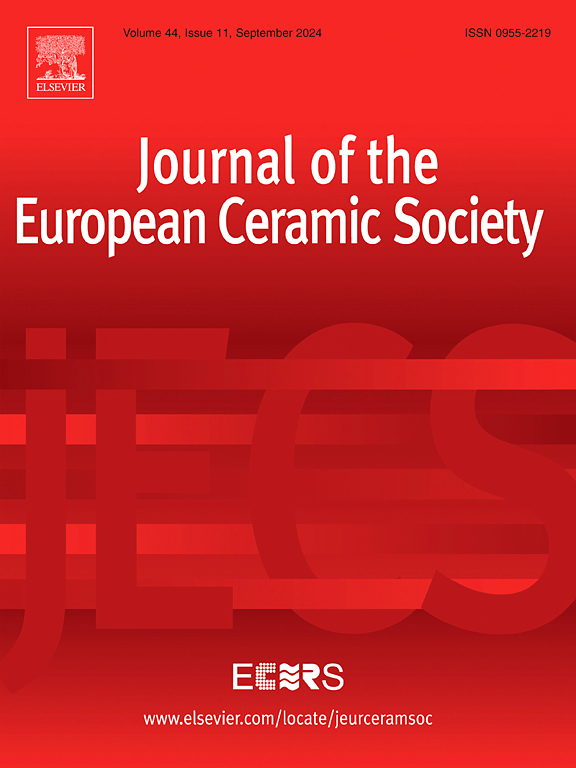Ablation-resistant Y2O3-modified (Hf0.2Ta0.2Zr0.2Ti0.2Nb0.2)C high entropy ceramics in oxyacetylene flame above 2100 °C
IF 6.2
2区 材料科学
Q1 MATERIALS SCIENCE, CERAMICS
Journal of The European Ceramic Society
Pub Date : 2025-07-29
DOI:10.1016/j.jeurceramsoc.2025.117723
引用次数: 0
Abstract
This study investigates the ablation behavior of Y2O3-modified (Hf0.2Ta0.2Zr0.2Ti0.2Nb0.2)C high-entropy ceramics (HECs) under oxyacetylene flame at temperatures above 2100 °C. The Y2O3 content is systematically varied (5–20 vol%), and it is found that the optimal 15 vol% Y2O3 content facilitates the in-situ formation of a dense gradient oxide layer. This layer integrates refractory (Nb, Ta)2O5 and (Hf, Zr, Me)Ox skeletons with a Y-rich molten matrix, effectively suppressing oxygen penetration and reducing the volatilization of low-melting-point oxides. The sample exhibits superior ablation resistance, with linear and mass ablation rates of −12.8 ± 0.7 × 10−3 mm/s and 2.5 ± 0.2 × 10−3 g/s, respectively, outperforming unmodified HECs and other Y2O3-modified ceramics. Thermodynamic simulations reveal that Y2O3 stabilizes the oxide layer through the formation of Y-containing compounds, achieving a good balance between liquid-phase filling and refractory skeleton integrity. These findings will advance the design of rare-earth-modified HECs for ultrahigh-temperature thermal protection systems in aerospace applications.
2100℃以上氧乙炔火焰中抗烧蚀y2o3改性(Hf0.2Ta0.2Zr0.2Ti0.2Nb0.2)C高熵陶瓷
研究了y2o3改性(Hf0.2Ta0.2Zr0.2Ti0.2Nb0.2)C高熵陶瓷(HECs)在2100℃以上氧乙炔火焰下的烧蚀行为。Y2O3含量系统地变化(5 ~ 20 vol%),发现最佳的15 vol% Y2O3含量有利于原位形成致密的梯度氧化层。该层将难熔的(Nb, Ta)2O5和(Hf, Zr, Me)Ox骨架与富含y的熔融基体结合在一起,有效地抑制了氧的渗透,减少了低熔点氧化物的挥发。样品表现出优异的抗烧蚀性能,线性烧蚀速率为- 12.8 ± 0.7 × 10−3 mm/s,质量烧蚀速率为2.5 ± 0.2 × 10−3 g/s,优于未改性的HECs和其他y2o3改性陶瓷。热力学模拟表明,Y2O3通过形成含y化合物来稳定氧化层,实现了液相填充和耐火材料骨架完整性之间的良好平衡。这些发现将推动稀土改性HECs在航空航天应用中用于超高温热保护系统的设计。
本文章由计算机程序翻译,如有差异,请以英文原文为准。
求助全文
约1分钟内获得全文
求助全文
来源期刊

Journal of The European Ceramic Society
工程技术-材料科学:硅酸盐
CiteScore
10.70
自引率
12.30%
发文量
863
审稿时长
35 days
期刊介绍:
The Journal of the European Ceramic Society publishes the results of original research and reviews relating to ceramic materials. Papers of either an experimental or theoretical character will be welcomed on a fully international basis. The emphasis is on novel generic science concerning the relationships between processing, microstructure and properties of polycrystalline ceramics consolidated at high temperature. Papers may relate to any of the conventional categories of ceramic: structural, functional, traditional or composite. The central objective is to sustain a high standard of research quality by means of appropriate reviewing procedures.
 求助内容:
求助内容: 应助结果提醒方式:
应助结果提醒方式:


